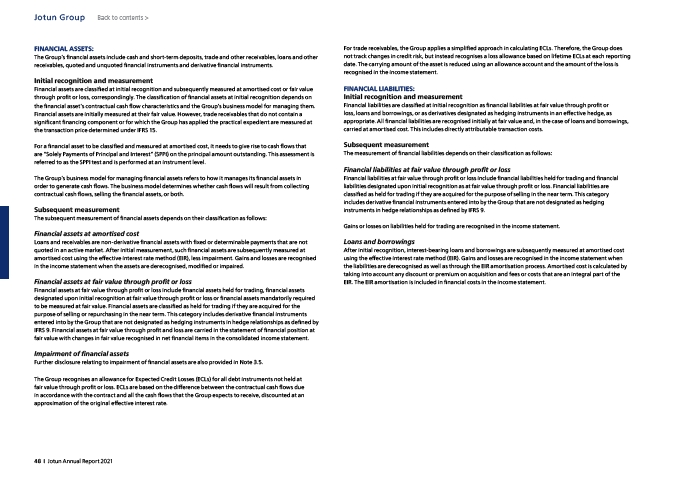
Jotun Group Back to contents >
FINANCIAL ASSETS:
The Group’s financial assets include cash and short-term deposits, trade and other receivables, loans and other
receivables, quoted and unquoted financial instruments and derivative financial instruments.
Initial recognition and measurement
Financial assets are classified at initial recognition and subsequently measured at amortised cost or fair value
through profit or loss, correspondingly. The classification of financial assets at initial recognition depends on
the financial asset’s contractual cash flow characteristics and the Group’s business model for managing them.
Financial assets are initially measured at their fair value. However, trade receivables that do not contain a
significant financing component or for which the Group has applied the practical expedient are measured at
the transaction price determined under IFRS 15.
For a financial asset to be classified and measured at amortised cost, it needs to give rise to cash flows that
are “Solely Payments of Principal and Interest” (SPPI) on the principal amount outstanding. This assessment is
referred to as the SPPI test and is performed at an instrument level.
The Group’s business model for managing financial assets refers to how it manages its financial assets in
order to generate cash flows. The business model determines whether cash flows will result from collecting
contractual cash flows, selling the financial assets, or both.
Subsequent measurement
The subsequent measurement of financial assets depends on their classification as follows:
Financial assets at amortised cost
Loans and receivables are non-derivative financial assets with fixed or determinable payments that are not
quoted in an active market. After initial measurement, such financial assets are subsequently measured at
amortised cost using the effective interest rate method (EIR), less impairment. Gains and losses are recognised
in the income statement when the assets are derecognised, modified or impaired.
Financial assets at fair value through profit or loss
Financial assets at fair value through profit or loss include financial assets held for trading, financial assets
designated upon initial recognition at fair value through profit or loss or financial assets mandatorily required
to be measured at fair value. Financial assets are classified as held for trading if they are acquired for the
purpose of selling or repurchasing in the near term. This category includes derivative financial instruments
entered into by the Group that are not designated as hedging instruments in hedge relationships as defined by
IFRS 9. Financial assets at fair value through profit and loss are carried in the statement of financial position at
fair value with changes in fair value recognised in net financial items in the consolidated income statement.
Impairment of financial assets
Further disclosure relating to impairment of financial assets are also provided in Note 3.5.
The Group recognises an allowance for Expected Credit Losses (ECLs) for all debt instruments not held at
fair value through profit or loss. ECLs are based on the difference between the contractual cash flows due
in accordance with the contract and all the cash flows that the Group expects to receive, discounted at an
approximation of the original effective interest rate.
For trade receivables, the Group applies a simplified approach in calculating ECLs. Therefore, the Group does
not track changes in credit risk, but instead recognises a loss allowance based on lifetime ECLs at each reporting
date. The carrying amount of the asset is reduced using an allowance account and the amount of the loss is
recognised in the income statement.
FINANCIAL LIABILITIES:
Initial recognition and measurement
Financial liabilities are classified at initial recognition as financial liabilities at fair value through profit or
loss, loans and borrowings, or as derivatives designated as hedging instruments in an effective hedge, as
appropriate. All financial liabilities are recognised initially at fair value and, in the case of loans and borrowings,
carried at amortised cost. This includes directly attributable transaction costs.
Subsequent measurement
The measurement of financial liabilities depends on their classification as follows:
Financial liabilities at fair value through profit or loss
Financial liabilities at fair value through profit or loss include financial liabilities held for trading and financial
liabilities designated upon initial recognition as at fair value through profit or loss. Financial liabilities are
classified as held for trading if they are acquired for the purpose of selling in the near term. This category
includes derivative financial instruments entered into by the Group that are not designated as hedging
instruments in hedge relationships as defined by IFRS 9.
Gains or losses on liabilities held for trading are recognised in the income statement.
Loans and borrowings
After initial recognition, interest-bearing loans and borrowings are subsequently measured at amortised cost
using the effective interest rate method (EIR). Gains and losses are recognised in the income statement when
the liabilities are derecognised as well as through the EIR amortisation process. Amortised cost is calculated by
taking into account any discount or premium on acquisition and fees or costs that are an integral part of the
EIR. The EIR amortisation is included in financial costs in the income statement.
48 I Jotun Annual Report 2021